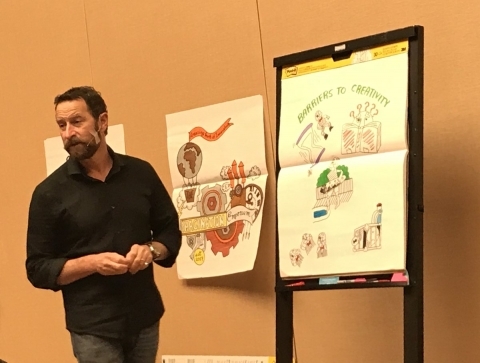How Playing Leads to Better Work: Lessons from Disney Innovation Guru Duncan Wardle

We’re all born curious – we came into the world with innate fascination and a desire to explore and experiment. As we get older and our lives are more structured, our creative self often takes a back seat to other life priorities.
As trade show and event organizers, we strive to be innovative, but the creative process is often mired in organizational layers. So the question becomes, how can we be truly creative in the face of personal and professional constraints?
The CEMA Roadshow workshop in Chicago earlier this month sought to answer that question. Under the sage guidance of former Disney Head of Innovation & Creativity, Duncan J. Wardle, the group spent a day rediscovering their creative cores and acquiring tools to break down creative barriers.
According to Wardle, creativity is about finding the best way to combine the “being” with the “doing.” The first step in “being” creative is to understand and practice creative behaviors. We can learn a lot about those from children — the things they do that adults don’t: imagine, play, have energy, ask why, be honest and don’t judge.
Playfulness helps remove daily structure and stress, allowing you to pursue all sorts of possibilities. A good way to play at work is to engage in energizing games at the outset of a brainstorm, or whenever energy drops. It helps to be perpetually curious. To do this, get fresh stimuli in your life: talk to someone you have nothing in common with or read a magazine you’ve never read. Bring curiosity to the table in brainstorms and ask “why?” as many times as you need to get to an insight.
On the flip side, insights also come from experience and intuition, so it’s important to tap into your conscience, feelings, “ah-ha!” moments and dreams.
Being creative also requires being open to nurturing ideas. We are often quick to dismiss ideas in their infancy because they seem impractical or don’t align with our worldview. Wardle argues that Ideas are like seeds. How do you know if they will become weeds or flowers? You have to let them grow.
A smart way to grow idea seedlings is to use the “Yes, and…” build method. By beginning each response to new thought with “Yes, and…” you can quickly build out a small idea, make it bigger, and transform it from “my idea” to “our idea,” which helps build team and organizational buy-in.
One of the more challenging lessons Wardle imparts is that to achieve a truly disruptive idea, you have to break rules, even your own. Every creative challenge is governed by rules — preconceived notions and institutional norms — that put boundaries on creative thinking. But what if those rules didn’t apply? You can find out and create dynamic, out-of-bounds ideas by radically provoking them with a simple question: “What if…”
People have rules too — a personal “river of thinking” that is formed by their knowledge and experience. These rivers may be fast, wide and deep, but they hold all of our “sacred cows,” which can limit our openness to new ideas. Encouraging “What if” ideas from the whole team will get everyone out of their personal rivers of thinking and opens ideation to all sorts of truly disruptive possibilities.
Another important wisdom is to look outside of your sandbox for insight and ingenuity. Innovation is about getting to an idea that you could not have found yourself. For your next brainstorm, invite a “naïve expert,” who doesn’t work for you or know what you are working on. This can help you and your team get out of your rivers of thinking.
Another wise Wardle maxim is that expansive (what can we do?) and reductive (can we do it?) thinking are both valuable in the creative process, but it’s important not to mix the two in your brainstorms. Slipping into reductive thinking – focusing on budgets, resources, timelines, etc. — during an ideation session can bring the best creative thinking to a halt.
To avoid inadvertent shifts to reductive thinking, make sure everyone knows whether it’s time to build ideas or analyze them. Also, steer clear of comments during the ideation process that can elicit reductive responses. For example, asking “what do you think?” invites reductive thinking. To stay expansive, re-frame the question to: ‘what else could we do?” or “is there a different way to think about this?”
Wardle advises to use reductionist thinking when it’s time to focus on “doing.” A good reductionist way to distill the best idea from a body of options is to test it against five criteria: strategically aligned with the brand, meets fiscal goals, is relevant to target consumer, is social engaging, and is buzz worthy. The best ideas score highest against all five criteria.
Another reductionist approach is to bullet-proof ideas by looking at them through the perspective “lens” of each of your stakeholders. Knowing who will support and who might object to your idea, and why, allows you to preemptively incorporate supportive feedback that strengthens the idea and resolve objections that can weaken it before you present it.
Wardle closed out the creativity crash course with two provocative thoughts: You were born creative, you are still creative, even if you’ve been told you’re not; and to be creative you must be brave, and the opposite of bravery is not cowardice – it’s conformity.
Kimberley Gishler is the president and CEO of CEMA.


Add new comment